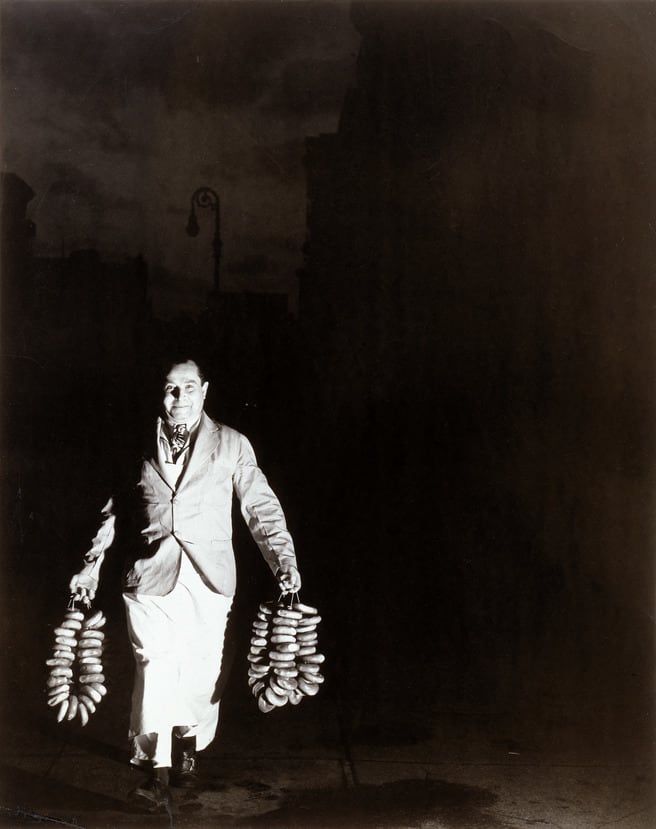
- Artist/Maker:
- Weegee (born Arthur Fellig)
- Bio:
- American, b. Poland, 1899-1968
- Title:
- Max Is Rushing in the Bagels to a Restaurant on Second Avenue for the Morning Trade
- Date:
- c. 1940
- Medium:
- Gelatin silver print
- Dimensions:
- Sheet: 16 × 20 in. (40.6 × 50.8 cm) Image: 14 3/4 × 18 7/8 in. (37.5 × 48 cm)
- Credit Line:
- Purchase: Joan B. and Richard L. Barovick Family Foundation and Bunny and Jim Weinberg Gifts
- Accession Number:
- 2000-72
- Copyright:
- © Weegee/International Center of Photography/Getty Images
Not On View
Weegee was a master at using his sharp, high-contrast images to capture glitzy, dynamic, and momentous occasions in all spheres, sometimes capturing the main event, but often focusing on the spectators. His subjects included circus and ballet performances, Easter Sunday in Harlem, a murder at the cinema, a raucous night at Sammy's bar on the Bowery, and a Coney Island beach teeming with Sunbathers. He depicts this New York as, in the words of art historian Max Kozloff, a "strip show gone bananas," often adding captions describing his adventures. The title for this photograph derives from a longer caption, in which Weegee indicates that his encounter with the "bagelman" occurred at six in the morning near the Consolidated Edison Company building on Fourteenth Street.
Calling his protagonist by his first name, Weegee alludes to camaraderie with the workers with whom he regularly shares the deserted streets in the dead of night and the wee hours of the morning. He captures Max midstep as he looks and moves self-assuredly toward the fleeting glare of the photographer's flash. Weegee called his flash his "Aladdin's lamp," which allowed him to achieve what he referred to as "Rembrandt light" to describe the way that his glowing figures emerged from the darkness. Although the street is shrouded in blackness and the cement squares on the ground are obscured by enigmatic shadows and grime, Weegee creates a sense of place by hinting at the silhouette of a lamppost in the background. Today, you can still find originals as well as replicas of street lamps of this style, known as bishop's crooks," lining the area around Union Square, where this photograph was taken, as well as in many other neighborhoods.
The police radio installed in his car gave Weegee his almost supernatural, Ouija-like ability to arrive at crime scenes before the police, likely earning him his nickname, although the name might also have derived from his early work as a photo assistant using a squeegee to dry prints. He was almost entirely self-taught. After several freelance assignments as a crime photographer, he became a staff photographer at PM, a left-leaning newspaper, in 1940. He became part of the first generation of what has become known as the New York School of photographers and was loosely affiliated with the Photo League, exhibiting Weegee: Murder Is My Business there in 1941. He often photographed in tandem with Lisette Model, who shared many of his subjects but often portrayed them in a more serious light. His candid depiction of his subjects and use of experimental techniques remained an integral part of his own work even later in life, when he moved to Hollywood and began creating distorted images of celebrities and consulting on special effects for films, including Stanley Kubrick's Dr. Strangelove. His legacy can be seen most vividly in his influence on the work of other photographers associated with the New York School, such as Diane Arbus, whose pictures often focus on individuals on the periphery of society.
Calling his protagonist by his first name, Weegee alludes to camaraderie with the workers with whom he regularly shares the deserted streets in the dead of night and the wee hours of the morning. He captures Max midstep as he looks and moves self-assuredly toward the fleeting glare of the photographer's flash. Weegee called his flash his "Aladdin's lamp," which allowed him to achieve what he referred to as "Rembrandt light" to describe the way that his glowing figures emerged from the darkness. Although the street is shrouded in blackness and the cement squares on the ground are obscured by enigmatic shadows and grime, Weegee creates a sense of place by hinting at the silhouette of a lamppost in the background. Today, you can still find originals as well as replicas of street lamps of this style, known as bishop's crooks," lining the area around Union Square, where this photograph was taken, as well as in many other neighborhoods.
The police radio installed in his car gave Weegee his almost supernatural, Ouija-like ability to arrive at crime scenes before the police, likely earning him his nickname, although the name might also have derived from his early work as a photo assistant using a squeegee to dry prints. He was almost entirely self-taught. After several freelance assignments as a crime photographer, he became a staff photographer at PM, a left-leaning newspaper, in 1940. He became part of the first generation of what has become known as the New York School of photographers and was loosely affiliated with the Photo League, exhibiting Weegee: Murder Is My Business there in 1941. He often photographed in tandem with Lisette Model, who shared many of his subjects but often portrayed them in a more serious light. His candid depiction of his subjects and use of experimental techniques remained an integral part of his own work even later in life, when he moved to Hollywood and began creating distorted images of celebrities and consulting on special effects for films, including Stanley Kubrick's Dr. Strangelove. His legacy can be seen most vividly in his influence on the work of other photographers associated with the New York School, such as Diane Arbus, whose pictures often focus on individuals on the periphery of society.
Information may change as a result of ongoing research.